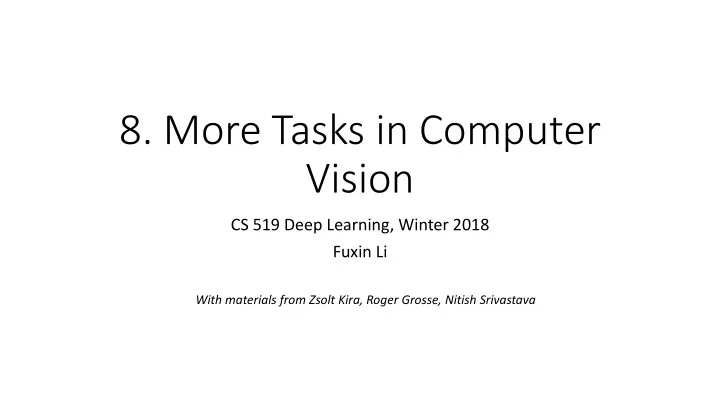

8. More Tasks in Computer Vision CS 519 Deep Learning, Winter 2018 Fuxin Li With materials from Zsolt Kira, Roger Grosse, Nitish Srivastava
Image Classification History • Caltech datasets: Caltech-256 • Caltech-101: 3,030 images in 101 categories • Caltech-256: 30,607 images in 256 categories • ImageNet • Full set: more than 10 million images • WordNet taxonomy • Challenge: 1.2 million images in 1,000 categories • Dog breeds
ImageNet
Dog breeds • More than 120 different dog breeds in the dataset • Hard for human to discriminate
ILSVRC (AlexNet) (VGG) 152-level Conv Net (covered later) 3.6%
AlexNet (60 million parameters)
The VGG Network (138 Million parameters) 224 x 224 224 x 224 112 x 112 56 x 56 28 x 28 14 x 14 7 x 7 …… Airplane Dog Car SUV Minivan Sign Pole (Simonyan and Zisserman 2014)
Softmax Cross-Entropy • Softmax layer in multi-class • Log-likelihood: • Loss function is minus log-likelihood 𝑓 𝒚 ⊤ 𝒙 𝑙 − log 𝑄(𝑧 = 𝑘|𝑦) = −𝒚 ⊤ 𝒙 𝑘 + log 𝑙 • Total energy: min 𝐗 σ 𝑗 − log 𝑄(𝑧 = 𝑧 𝑗 |𝑦 𝑗 )
Reinforcement Learning: Atari games • Predict the Q-function (value function) of each move using the current scene as input • Use normal MDP value iterations to decide the best current move Mnih et al. Playing Atari with Deep Reinforcement Learning
Reinforcement Learning: Playing go • Predict next 3 moves using CNN • Combine with Monte Carlo Tree Search to obtain state-of-the-art go- playing system Tian and Zhu. arXiv 0511:06410
Object Detection • Faster/Mask R-CNN: • Deep network on object proposals • Jointly train network to propose boxes inside the image and classification in the box
Predicting Regions
Segment-based Framework Semantic Segmentation • Given an image, identify the category and spatial extent of all relevant objects Image Category Label Object Label Obj 1 Obj 3 Person Person Horse Obj 2 Horse Obj 4 14
Fully Convolutional Network • Idea – Fully connected can be turned into fully-convolutional • Zero-padding can help outputting more numbers! 4096 512 Convolve 7 7 7x7 filters 7 7
Decoding Step (Deconvolution) • Can also train network to “decode” • Suppose CNN is an “encoding” process • One could train a “decoder” to retain the full image resolution • Decoder is another CNN, with filter weights tied/not tied to the filter weights in the “encoder” CNN • One could use “Un -max- pooling” to increase resolution
Deconvolution used for finer details • Same convolutional networks – deconvolute all the way H. Noh, S. Hong, B. Han. Learning Deconvolution Network for Semantic Segmentation. ICCV 2015
Deconvolution Some Conv result Un-max-pooling Deconvolution Un-max-pooling Deconvolution Un-max-pooling Deconvolution Un-max-pooling Deconvolution
U-Net: Add linkage • Add linkage between conv layers and deconv layers with the same resolution • Improve spatial precision and helps at boundaries (low-level information)
Sample results for deconvolution-based semantic segmentation
Other trivia: Fine-Tuning • Take pre-trained network • Remove last layer • Add your new layer • Say with 10 classes • Best results • Train last layer • Retrain entire network
Fine-tuning
Recommend
More recommend